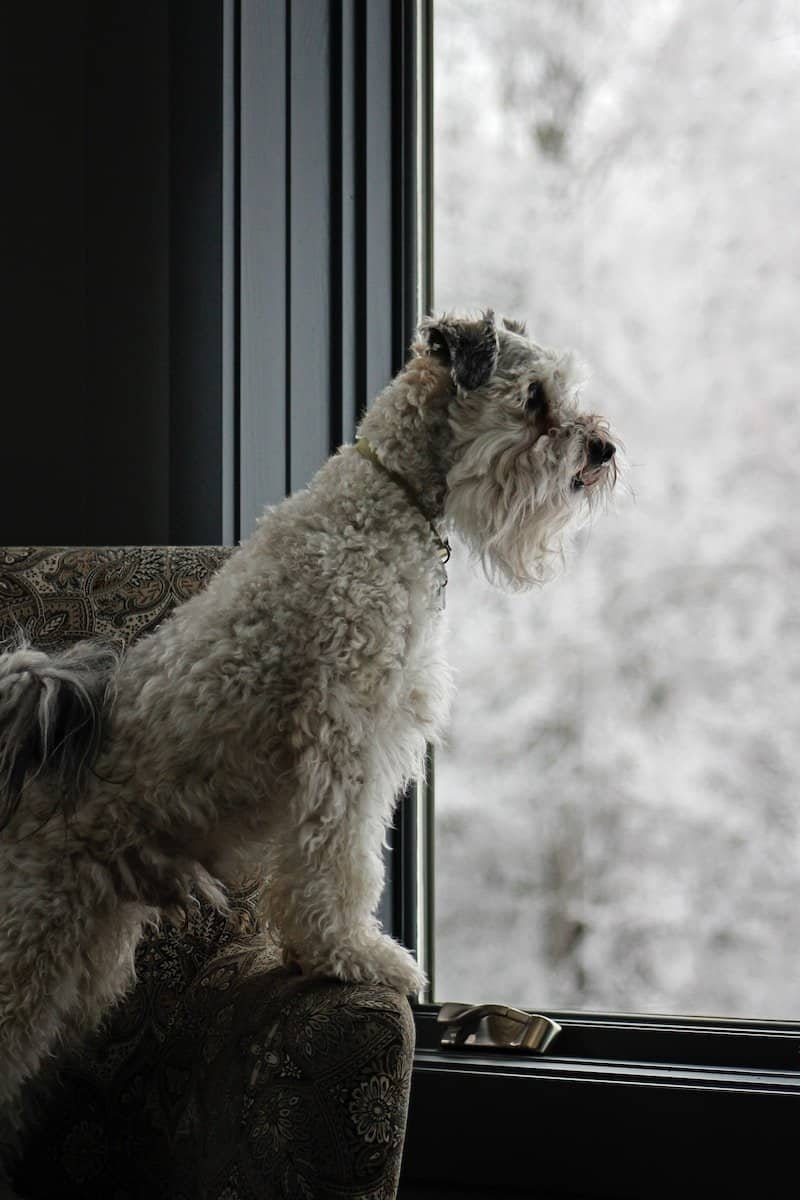If you are a poodle owner, you may be familiar with the challenges of leaving your furry friend alone at home. Poodles are known for their sensitive nature and may develop separation anxiety when left alone. Separation anxiety is a common condition that affects many dogs, and it can lead to destructive behavior, excessive barking, and other unwanted behaviors. Luckily, there are techniques you can use to help your poodle cope with separation anxiety.
Understanding separation anxiety is the first step in managing it. Separation anxiety is a condition where a dog becomes anxious and stressed when separated from its owner. It is important to recognize the symptoms of separation anxiety, such as excessive barking, whining, destruction of property, or attempts at escape. Once you understand the condition, you can take steps to manage it and help your poodle feel more comfortable when you are away.
There are several techniques you can use to help your poodle cope with separation anxiety. These techniques include training, exercise, positive reinforcement, and a healthy diet. You can also seek professional assistance or consider medications for severe cases. In this article, we will explore these techniques in more detail and answer some frequently asked questions about separation anxiety in poodles.
Key Takeaways
- Separation anxiety is a common condition that affects many dogs, including poodles.
- Understanding the condition and recognizing the symptoms is the first step in managing it.
- Techniques such as training, exercise, positive reinforcement, and a healthy diet can help your poodle cope with separation anxiety.
Understanding Separation Anxiety
If you’re a poodle owner, you may have noticed that your furry friend becomes anxious and stressed when left alone. This condition is known as separation anxiety and is a common behavioral issue in dogs. Separation anxiety occurs when dogs become overly attached to their owners or other members of the household and experience distress and anxiety when left alone.
Some of the signs of separation anxiety in poodles include excessive barking, whining, destruction of property, or attempts at escape. These behaviors not only disrupt the owner’s peace of mind but also indicate the dog’s emotional struggle in coping with their perceived abandonment.
It is important to note that separation anxiety is not a sign of disobedience or a lack of training. It is a genuine anxiety issue that requires patience and understanding to resolve.
If you suspect that your poodle is suffering from separation anxiety, it is important to consult with a veterinarian or a professional dog trainer. They can help identify the root cause of the anxiety and provide guidance on how to manage it effectively.
In the next section, we will discuss some techniques that can help your poodle cope with separation anxiety.
Causes of Separation Anxiety in Poodles
Separation anxiety is a common problem among dogs, and poodles are no exception. Separation anxiety is a condition where dogs become anxious and stressed when left alone or separated from their owners. Poodles are particularly susceptible to separation anxiety due to their nature and temperament.
There are several causes of separation anxiety in poodles. One of the most common causes is a change in routine or environment. Poodles are creatures of habit and thrive on a predictable routine. A sudden change in their routine, such as a new home or a new family member, can trigger separation anxiety.
Another cause of separation anxiety in poodles is genetics. Just like humans, dogs can inherit certain traits and predispositions from their parents. If a poodle is prone to developing separation anxiety, it is likely that one or both of its parents also suffer from the disorder.
Medical problems can also cause separation anxiety in poodles. If your poodle is experiencing pain or discomfort, it may become anxious and stressed when left alone. It’s important to rule out any underlying medical conditions before treating separation anxiety.
In addition to the above causes, poor diet, lack of exercise, and lack of mental stimulation can also contribute to separation anxiety in poodles. A well-balanced diet, regular exercise, and plenty of mental stimulation can help reduce your poodle’s anxiety.
Understanding the causes of separation anxiety in poodles is the first step in helping your furry friend cope with this condition. By addressing the underlying causes and providing your poodle with the necessary care and attention, you can help reduce their anxiety and improve their overall well-being.
Recognizing Symptoms
Separation anxiety is a common issue in poodles, and it can manifest in various ways. Some of the most common symptoms of separation anxiety in poodles include pacing, anxious behavior, barking, panting, howling, whining, destructive behavior, chewing, urinating, defecating, digging, excessive barking or howling, physical symptoms, destruction of property, excessive barking and howling, restless and agitated behavior.
If you notice that your poodle exhibits any of these behaviors when you leave the house, it is likely that your furry friend is suffering from separation anxiety. It’s important to recognize these symptoms so that you can take the necessary steps to alleviate your poodle’s anxiety.
One of the most common symptoms of separation anxiety in poodles is excessive barking or howling. If your poodle barks or howls excessively when you leave the house, it may be a sign that your dog is anxious and upset. Another common symptom is destructive behavior, such as chewing on furniture or digging holes in the yard. If you come home to find that your poodle has destroyed your belongings, it may be a sign that your dog is suffering from separation anxiety.
In addition to these behavioral symptoms, your poodle may also exhibit physical symptoms of separation anxiety, such as panting, whining, and pacing. If you notice that your poodle is restless and agitated when you leave the house, it may be a sign that your dog is experiencing separation anxiety.
By recognizing the symptoms of separation anxiety in your poodle, you can take the necessary steps to help your furry friend cope with their anxiety and feel more comfortable when you’re not home.
Managing Separation Anxiety
Separation anxiety in poodles can be a challenging issue to manage, but there are techniques that can help your furry friend cope with being alone. Here are some tips to help you manage your poodle’s separation anxiety:
- Establish a consistent routine: Consistency is key when it comes to managing separation anxiety. Establish a daily routine for your poodle that includes regular meal times, exercise, and alone time. This will help your poodle feel more secure and less anxious when you are away.
- Provide mental stimulation: Mental stimulation can help keep your poodle’s mind active and engaged. Interactive toys, brain training exercises, and puzzles can help keep your poodle entertained and distracted while you are away.
- Desensitize your poodle to being alone: Gradually getting your poodle used to being alone can help reduce separation anxiety. Start by leaving your poodle alone for short periods of time and gradually increase the duration over time.
- Counterconditioning: Counterconditioning involves changing your poodle’s emotional response to being alone. This can be done by associating positive experiences with being alone, such as giving your poodle a treat or toy when you leave.
- Consider medication: In severe cases, medication may be necessary to help manage your poodle’s separation anxiety. Talk to your veterinarian about whether medication is a good option for your poodle.
- Use a pheromone diffuser: Pheromone diffusers can help calm your poodle and reduce anxiety. These diffusers release pheromones that mimic the natural calming scents that dogs produce.
- Positive reinforcement: Positive reinforcement can be an effective way to manage separation anxiety. Reward your poodle for good behavior and ignore bad behavior.
- Enrichment activities: Enrichment activities, such as hiding treats around the house or providing your poodle with interactive toys, can help keep your poodle entertained and reduce anxiety.
- TV or music: Leaving the TV or radio on can help provide background noise and make your poodle feel less alone.
By implementing these techniques, you can help your poodle cope with separation anxiety and feel more comfortable when you are away. Remember, managing separation anxiety takes time and patience, but with consistency and positive reinforcement, you can help your poodle feel more secure and less anxious.
Professional Assistance
If you have tried various techniques to help your poodle cope with separation anxiety but nothing seems to work, it may be time to seek professional help. There are several options available, including hiring a dog trainer, dog sitter, or dog walker, consulting with a certified applied animal behaviorist or veterinary behaviorist, and working with a certified professional dog trainer.
A dog trainer can help you identify the root cause of your poodle’s separation anxiety and develop a customized training plan to address the issue. They can also teach you techniques to help your poodle feel more comfortable when left alone and provide guidance on how to reinforce positive behaviors.
If you need someone to care for your poodle while you are away, consider hiring a dog sitter or dog walker. These professionals can provide companionship and exercise for your poodle, which can help reduce their anxiety. They can also monitor your poodle’s behavior and alert you to any issues that may arise.
For more complex cases of separation anxiety, it may be necessary to consult with a certified applied animal behaviorist or veterinary behaviorist. These professionals have advanced training in animal behavior and can develop a comprehensive treatment plan to help your poodle overcome their anxiety.
Finally, a certified professional dog trainer can provide guidance on how to manage your poodle’s separation anxiety and help you develop a training plan to address the issue. They can also teach you how to reinforce positive behaviors and discourage negative ones.
Regardless of which professional you choose, make sure they have experience working with poodles and are certified by a reputable organization. With the right help, you can help your poodle overcome their separation anxiety and lead a happier, more comfortable life.
Preventive Measures
Separation anxiety can be a challenging condition for poodle owners to manage. However, there are several preventive measures that you can take to help your poodle cope with separation anxiety.
One of the most effective preventive measures is to create a comfortable and safe environment for your poodle. This includes providing them with a cozy bed, plenty of toys, and access to food and water. Additionally, make sure your poodle has access to a designated potty area to prevent accidents and reduce stress.
Another preventive measure is to establish a routine for your poodle. Consistency is key when it comes to preventing separation anxiety in poodles. Establishing a routine for feeding, exercise, and playtime can help reduce stress and anxiety.
Boredom is a common trigger for separation anxiety in poodles. To prevent boredom, make sure your poodle has plenty of toys and activities to keep them entertained. Puzzle toys, interactive toys, and chew toys can all help keep your poodle occupied and prevent them from feeling anxious or stressed.
If you have other pets in your home, it is important to make sure they get along with your poodle. Cats, in particular, can be a source of stress and anxiety for poodles. If your poodle is showing signs of anxiety around other pets, consider separating them or seeking professional help.
If you are adopting a poodle from a shelter, it is important to be aware that they may be more prone to separation anxiety. This is because they may have experienced trauma or abandonment in the past. To prevent separation anxiety in shelter dogs, provide them with plenty of love, attention, and a comfortable living environment.
Finally, it is important to discourage coprophagia, or eating feces, in poodles. This behavior can be a sign of stress and anxiety and can exacerbate separation anxiety. To prevent coprophagia, make sure your poodle has access to clean water and a healthy, balanced diet. Additionally, consider using deterrents or training techniques to discourage this behavior.
By taking these preventive measures, you can help your poodle feel safe, comfortable, and happy, reducing their risk of separation anxiety.
Medications for Separation Anxiety
If your poodle is experiencing severe separation anxiety, medication may be necessary to help manage their symptoms. However, medication should always be used in conjunction with behavior modification techniques and under the guidance of a veterinarian.
One medication commonly used to treat separation anxiety in dogs is Clomipramine (Clomicalm). This medication acts on two levels – serotonin and norepinephrine – and is more efficient when administered twice per day. It is worth mentioning that clomipramine is one of two FDA-approved drugs for dogs with separation anxiety.
Another medication that may be prescribed by a veterinarian is Fluoxetine (Prozac). This medication is an antidepressant that increases the levels of serotonin in the brain. It can take several weeks for the medication to take effect, and it should be used in conjunction with behavior modification techniques.
Other medications that may be prescribed by a veterinarian include Diazepam (Valium) and Alprazolam (Xanax). These medications are benzodiazepines and work by increasing the levels of gamma-aminobutyric acid (GABA) in the brain, which helps to reduce anxiety. However, these medications can be habit-forming and should only be used for short periods of time.
It is important to note that medication should never be the sole treatment for separation anxiety in dogs. Behavior modification techniques, such as desensitization and counterconditioning, should also be used in conjunction with medication to help your poodle cope with their anxiety.
Separation Anxiety in Other Pets
While we’re focusing on poodles, it’s worth noting that separation anxiety is not unique to this breed. Many pets, including cats, can experience anxiety when left alone.
Cats are known for their independent nature, but they can still experience separation anxiety. Some signs of separation anxiety in cats include excessive meowing or yowling, destructive behavior, and litter box issues.
If you have multiple pets, it’s possible that one pet’s separation anxiety can trigger anxiety in another pet. This can be especially true if the two pets are particularly bonded.
It’s important to remember that each pet is unique and may require different techniques to manage their anxiety. If you have multiple pets, it’s important to take each pet’s needs into consideration when developing a plan to manage separation anxiety.
Overall, separation anxiety is a common issue among pets. By understanding the signs of separation anxiety and implementing techniques to manage it, you can help your furry friend feel more comfortable when you’re away.
Frequently Asked Questions
If you’re a Poodle owner, you may have some questions about how to help your furry friend cope with separation anxiety. Here are some frequently asked questions and their answers.
What are some effective techniques for helping dogs cope with separation anxiety?
There are several effective techniques for helping dogs cope with separation anxiety. Some of these include:
- Gradually increasing the amount of time your Poodle spends alone
- Providing your dog with plenty of exercise and mental stimulation
- Using calming aids such as pheromone sprays or calming music
- Desensitizing your dog to departure cues such as picking up your keys or putting on your coat
How can I train my Poodle to stay home alone?
Training your Poodle to stay home alone can take time and patience, but it is possible. Some tips for training your Poodle to stay home alone include:
- Starting with short periods of time and gradually increasing the amount of time your Poodle spends alone
- Rewarding your Poodle for calm behavior when you leave and return
- Providing your Poodle with plenty of exercise and mental stimulation before you leave
- Using a crate or designated safe space for your Poodle while you’re away
What are the symptoms of separation anxiety in dogs?
The symptoms of separation anxiety in dogs can vary, but some common signs include:
- Excessive barking or howling
- Destructive behavior such as chewing or digging
- Attempts to escape
- Urinating or defecating in the house
- Pacing or restlessness
Is it possible to cure separation anxiety in dogs?
While there is no cure for separation anxiety in dogs, it is possible to manage the condition and reduce your dog’s anxiety. This may involve a combination of training, medication, and behavioral modification.
What are some common medications used to treat separation anxiety in dogs?
Some common medications used to treat separation anxiety in dogs include:
- Selective serotonin reuptake inhibitors (SSRIs)
- Tricyclic antidepressants (TCAs)
- Benzodiazepines
It’s important to note that medication should only be used under the guidance of a veterinarian.
How can I help my Poodle with severe separation anxiety?
If your Poodle has severe separation anxiety, it’s important to work with a veterinarian or animal behaviorist to develop a treatment plan. This may involve a combination of training, medication, and behavioral modification. It’s important to be patient and consistent in your efforts to help your Poodle cope with separation anxiety.



